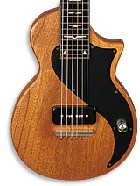
Wayne Charvel’s name is familiar to any guitarist who was on the scene in the 1980s. If that rock star or bar wunderkind you saw was playing something with a pointy headstock and locking vibrato, there was a pretty good chance the headstock said “Charvel.”
In the 1960s, Charvel was experimenting with guitar repairs and refinishing. By the early ’70s he went to work for Fender, and in ’74 opened his own shop, building, refinishing, and distributing parts. His axes were high-quality bolt-necks with an array of pickup combinations, and it didn’t take long for them to make it into the hands of famous players.
In the late ’80s, the Charvel name was sold, and production moved overseas. Ten years later, Charvel was once again building solidbody electric guitars, this time under the “Wayne” moniker. Recently, though, they offered up a brand spankin’ new model (and concept!); a lap steel shaped in classic single-cut style and boasting a one-piece mahogany body and neck finished in hand-rubbed oil. True, lap steels aren’t for everybody and the Hawaiian-music craze died 50 years ago, but as of late there has been a resurgence as players discover the many types of music that can accomodate a lap steel.
Wayne’s new headstock design features a straight string pull with a tree on the B and E strings, and a small metal logo plate screwed to the front. The bridge and nut are made of specially designed billet aluminum. Tuners are Sperzel locking and the strings (medium weight with a wound third) are rear-loaded. The 24-fret plexiglas fingerboard uses art deco markers carved from the back. A graceful single-layer pickguard adorns the face.
Electronics on the Wayne are simple and straightforward – a single Seymour Duncan Vintage P-90 pickup with a volume control. Scale length is 231/2″ and the nut is 21/16″ wide. A peek in the rear electronics compartment revealed wiring that was heavy duty, and neatly executed.
Weighing in at about six pounds, the littlest Wayne has some heft for its size. But that doesn’t detract from the way it sits on the lap. It does, however, add to the sustain and tone (more on that soon!). Craftsmanship is top-notch, with fantastic attention to detail.
To see what the Wayne had to offer in the way of sounds, we grabbed our all-tube Peavey Butcher head with 2×12″ cab with nothing but a cable between the guitar and amp. We set the Butcher to clean and plucked a few notes of the open E-tuned Wayne. Wow! Apart from the outstanding tone from the Duncan, the predominant thought running through our minds was “Sustain.” Sliding the bar to the A chord… more sustain.
Itching to shift our new baby into overdrive, we set the Butcher to overdrive and were completely blown away. She growled, she moaned, she just plain killed! Single notes screamed, low-end was huge and tight. Note separation was fantastic, in clean or overdrive. “Dust My Broom” flowed through our hands as if being channeled. The amalgamation, or chemistry, or whatever it is of this guitar makes for some of the best tone and sustain you could possibly imagine getting from a lap steel.
Anyway, back to Earth… A final technical note; the volume control was tapered very evenly, so smooth swells were easy. And if we could be so bold, a suggestion; because this guitar sustains so nicely due in part by the billet aluminum, perhaps Wayne could build an aluminum-bar slide?
With this instrument, Wayne Charvel makes a strong case for anyone who’d argue that nobody building solidbody guitars today does it any better. The quality of materials and build, along with the outstanding tone and sustain, are all the evidence they’d need.
Wayne Lap Steel
Features One piece premium grade mahogany body/neck, hand-rubbed oil finish, billet aircraft aluminum bridge and nut, Sperzel locking machine heads, Deco design 24-fret fretboard, Seymour Duncan vintage P-90 style pickup, G&G custom hard case.
Price $599 (direct)
Contact Wayne Guitars, (530) 872-5123, www.wayneguitars.com.
This article originally appeared in VG‘s Dec. ’04 issue. All copyrights are by the author and Vintage Guitar magazine. Unauthorized replication or use is strictly prohibited.



